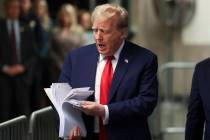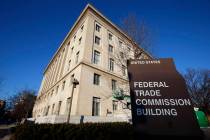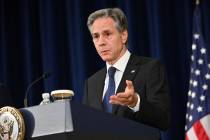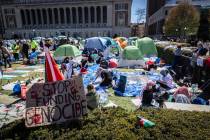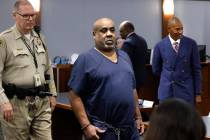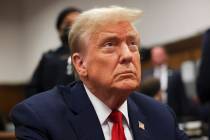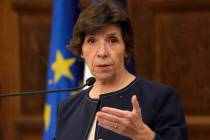Regents reject proposed tuition increase
There will be no tuition hike. Not now, anyway.
University system Chancellor Jim Rogers, the man who pitched the tuition hike in the first place, said Thursday that an increase for this year was “absolutely dead.”
The system’s Board of Regents was expected to take up the idea of an increase at its meeting Thursday.
But Board of Regents Chairman Michael Wixom essentially pulled any tuition increase from consideration before the meeting held at the University of Nevada, Las Vegas started.
And it wasn’t because of the 200 or so students who came to protest an increase, especially the 25 percent hike Rogers suggested a couple of weeks ago.
Wixom said he believes that higher education will be shielded from more cuts this year by a developing agreement between lawmakers and the governor. The proposed plan is for state government to secure a $160 million line of credit from Nevada’s Local Government Investment Pool to cover ongoing expenses.
The plan will be discussed next week during a special legislative session called by Gov. Jim Gibbons.
The university system has already made cuts of 14 percent this year because of state funding shortfalls brought on by economic woes. It will probably have to cut more next year if the state’s budget situation doesn’t improve.
No one thinks it’s going to improve, which means regents may later raise tuition for next year.
Which brings us back to the throng of students who showed up at Thursday’s meeting.
The crowd filled a huge room at the International Gaming Institute at UNLV. They mostly wore red, and some of them carried signs with slogans like “Save UNLV” or “Students First.”
The showing was unusual. UNLV students have been less than enthusiastic about getting involved in causes, even those that affect them. A September symposium intended to let students know how state budget cuts would affect them -- classes eliminated, staffing reduced, the possibility of entire programs going away -- drew a scant couple of dozen students, while a similar event drew several hundred faculty members.
Rogers, who has often pleaded for more public support, gave the students who showed up Thursday backhanded praise.
“I am delighted that every one of you is here,” he told them.
They applauded loudly.
“Why has it taken you so long?” Rogers asked.
The chancellor said the system was $775 million short of where it should be. He said that fact alone should have gotten the students involved.
They should have been writing their legislators and the governor. Rogers noted that it took the very real prospect of the government reaching into their nearly empty pocketbooks for them to act.
“You are the most powerful group in this state,” he said. “And it is about time that you started doing something.”
Rogers encouraged letter writing, and faxing, and e-mailing, and phone calls.
The students promised they’d oblige.
Nevada State College Student Body President Ryan Crowell approached the microphone. He said the students would hold protest assemblies on all the campuses Jan. 22.
Student after student followed him to the podium.
One dropped off 3,204 signatures opposing the tuition increase.
Another quoted one of Rogers’ own memos about the cuts.
Another said he was putting all elected officials on notice that the state’s college students were finally watching them.
Lastly, UNLV’s Student Body Vice President Vik Sehdev took the podium. The mechanical engineering student asked the crowd to be louder.
They cheered.
He said a $775 million shortfall is unacceptable.
“This fight just started,” Sehdev said. “We have a long time to go.”
The crowd roared.
“Now we go bigger,” he said. “We go faster. And we go stronger. So put on your seat belts and let’s go.”
Rogers, the man who called a press conference three weeks ago and floated the idea of a 25 percent increase, was smiling.
He took a stroll down the hallway afterwards.
He was asked if, maybe, he had thrown that 25 percent figure out there on purpose, so that exactly this would happen, so that students would finally get involved, so they would pressure lawmakers to stop cutting higher education.
He smiled again.
“I had to have something that would jolt them,” Rogers said. “Five percent wouldn’t do it. If I’d said 50 percent, everyone would think I was crazy.”
But 25 percent? It was just enough to get the students attention, Rogers said.
“It worked.”
Contact reporter Richard Lake at rlake@reviewjournal.com or 702-383-0307.








